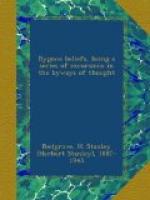At least three varieties of opinion can be traced from the view of sex we have under consideration, as to the nature of the perfect man, and hence of the most adequate symbol for transmutation. According to one, and this appears to have been JACOB BOEHME’S view, the perfect man is conceived of as non-sexual, the male and female elements united in him having, as it were, neutralised each other. According to another, he is pictured as a hermaphroditic being, a concept we frequently come across in alchemical literature. It plays a prominent part in MAIER’S book Atalanta Fugiens, to which reference has already been made. MAIER’S hermaphrodite has two heads, one male, one female, but only one body, one pair of arms, and one pair of legs. The two sexual organs, which are placed side by side, are delineated in the illustrations with considerable care, showing the importance MAIER attached to the idea. This concept seems to me not only crude, but unnatural and repellent. But it may be said of both the opinions I have mentioned, that they confuse between union and identity. It is the old mistake, with respect to a lesser goal, of those who hope for absorption in the Divine Nature and consequent loss of personality. It seems to be forgotten that a certain degree of distinction is necessary to the joy of union. “Distinction” and “separation,” it should be remembered, have different connotations. If the supreme joy is that of self-sacrifice, then the self must be such that it can be continually sacrificed, else the joy is a purely transitory one, or rather, is destroyed at the moment of its consummation. Hence, though sacrificed, the self must still remain itself.
The third view of perfection, to which these remarks naturally lead, is that which sees it typified in marriage. The mystic-philosopher SWEDENBORG has some exceedingly suggestive things to say on the matter in his extraordinary work on Conjugial Love, which, curiously enough, seem largely to have escaped the notice of students of these high mysteries.
SWEDENBORG’S heaven is a sexual heaven, because for him sex is primarily a spiritual fact, and only secondarily, and because of what it is primarily, a physical fact; and salvation is hardly possible, according to him, apart from a genuine marriage (whether achieved here or hereafter). Man and woman are considered as complementary beings, and it is only through the union of one man with one woman that the perfect angel results. The altruistic tendency of such a theory as contrasted with the egotism of one in which perfection is regarded as obtainable by each personality of itself alone, is a point worth emphasising. As to the nature of this union, it is, to use SWEDENBORG’S own terms, a conjunction of the will of the wife with the understanding of the man, and reciprocally of the understanding of the man with the will of the wife. It is thus a manifestation of that fundamental marriage between




